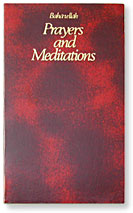
Last night I attended a study class which was about the book Prayers and Meditations by Baha’u’llah. I had come across this book before, as a compilation of prayers, but never took the time to look through it or use many of the prayers within it, as the more common “Baha’i Prayers” is easier with its shorter selection and thematic grouping. However, after this class I have a much better appreciation of this book and hope to make better use of it.
About the book

Ruhiyyih Khanum in the Priceless Pearl has described this book as a “diamond-mine of communion with God, unsurpassed in any religious literature of the world.” Some more references to the book that I found:
In 1935 Shoghi Effendi published a compilation of excerpts called Gleanings from the Writings of Bahá’u’lláh, which he himself has described as ‘consisting of a selection of the most characteristic and hitherto unpublished passages from the outstanding works of the Author of the Bahá’í Revelation.’ This was followed by the translation in 1936-1937, and publishing in 1938 of what might almost be termed a companion volume, comparable in richness and complementary in material, namely, Prayers and Meditations by Bahá’u’lláh.
(Ruhiyyih Khanum, The Priceless Pearl, p. 218)
“He is indeed pleased to know that the Book of Prayers and Meditations by Bahá’u’lláh has been out in time to enable the friends to read it during the Fast, and he has every hope that the perusal of such a precious volume will help to deepen more than any other publication, the spirit of devotion and faith in the friends, and thus charge them with all the spiritual power they require for the accomplishment of their tremendous duties towards the Cause.”
(Shoghi Effendi, Directives from the Guardian, p. 58)
A brief look at the content
Some prayers we are already familiar with are included, such as the short healing prayer and the tablet of visitation for Baha’u’llah:
170/CLXX: Thy Name Is My Healing, O My God, And Remembrance… (HEALING)
180/CLXXX: The Praise Which Hath Dawned From Thy Most… (TABLET OF VISITATION)
Also, the three obligatory prayers and the prayer for the dead:
167/CLXVII: O My God! This Is Thy Servant And The Son Of… (PRAYER FOR THE DEAD)
181/CLXXXI: I Bear Witness, O My God, That Thou Hast Created… (SHORT OBLIGATORY PRAYER)
182/CLXXXII: Whoso Wisheth To Pray, Let Him Wash… (MEDIUM OBLIGATORY PRAYER)
183/CLXXXIII: Whoso Wisheth To Recite This Prayer, Let… (LONG OBLIGATORY PRAYER)
A number of prayers for the fast, as well as a long prayer which I think would be great to say during the fast:
7/VII: Praise Be To Thee, O Lord My God! I Beseech Thee… (FAST)
45/XLV: My God, My Fire And My Light! The Days Which… (AYYAM-I-HA)
46/XLVI: Praised Be Thou, O My God, That Thou Hast Ordained… (NAW RUZ)
56/LVI: Glory Be To Thee, O Lord My God! These Are The… (FAST)
85/LXXXV: These Are, O My God, The Days Whereon Thou Didst… (FAST)
176/CLXXVI: Praise Be Unto Thee, Who Art My God And The… (LONG)
177/CLXXVII: I Beseech Thee, O My God, By Thy Mighty Sign,… (FAST)
178/CLXXVIII: Praised Be Thou, O Lord My God! I Supplicate… (FAST)
In addition to the above, some of the themes to be encountered are:
- the colloquy and relationship between the Supreme Revelator and His Creator
- the bewildering power of the Almighty, His attributes and exaltation above the realm of being
- the relative unreality of creational existence, yet the tender acceptance by a loving God of all that His creatures can offer in praise and service
- the brutal facts of everyday living of the early believers, in exile and at ‘Akka, and the contrast with the Covenant breakers
- the exhortation and reminders to those same believers in which Bahá’u’lláh Himself also indicated that His tribulations served but to advance His Cause
Systematic study
In our study class we were given a copy of a short article, published in the British Bahá’í Journal in December 1964, which provides a description and study guide for this book. Some of the activities suggested in the article (which has more detail and examples):
- A study of the attributes of God, their variety, range and cogent cumulative effect
- Selection of a specific Bahá’í teachings then tracing them through the book and allowing the cross comparison of the passages so found to play upon and enrich each other, adding meaning and value
- Observing the perfect blending of the different kinds of prayer
- A straight search for perfectly phrased, astonishingly logical and gloriously fuller amplification of truth in gemlike utterances that occur all through the book
- Appreciating the soul-moving range of Bahá’u’lláh’s own expression of Himself and of His circumstances
- The simple felicity of phrasing and the cadences are often most stirring and invite the reminder that prayers are aided by adding the sense of hearing to the sense of sight in conformity with the sense of the Word
- Whole paragraphs of most memorable content occur in many of the prayers, and each of us may like to build his own private anthology of them
- A particularly interesting study is the concept of ‘remembrance of God’ and the meanings it gathers to itself in the different contexts of its appearance
An activity suggested in the class was to identify and tabulate references to the Living Waters, which occur maybe thirty times in the text.
Another activity that can be associated with this book is memorization; there are many prayers and quotations that are good candidates to be memorized – in fact one could memorize the whole thing, giving added meaning to immersing oneself in the ocean of His words.
Roman Numerals
 A final note, on the numbering system used in some publications of this book including in the version provided on the Baha’i Reference Library website; Roman numerals are used, therefore it may be worth taking a few minutes to learn how to read them.
A final note, on the numbering system used in some publications of this book including in the version provided on the Baha’i Reference Library website; Roman numerals are used, therefore it may be worth taking a few minutes to learn how to read them.
Roman numerals are, as the name implies, a number system attributed to the Romans. The system includes certain symbols for numbers, and some rules for combining the symbols when they appear together to make up a number (by adding or subtracting their corresponding values). The symbols used are:
| Symbol | Value |
|---|---|
| I | 1 (one) |
| V | 5 (five) |
| X | 10 (ten) |
| L | 50 (fifty) |
| C | 100 (one hundred) |
| D | 500 (five hundred) |
| M | 1000 (one thousand) |
The first rule is that you add up the symbols when they appear together. For example, XX is twenty. Or VI is six. The second rule however, is that if you put a smaller symbol before a bigger one you subtract the value of the smaller one from the bigger one. For example, IV is four. Or XC is 90. There are some more rules but these two are enough to be able to read and make sense of the roman numerals that appear in this book.
For a little practice with the first three numbers, here’s a game matching Roman to Arabic numerals: http://www.fi.edu/time/keepers/Silverman/html/RomanMatch.html
To help recall the order of the last four symbols, here are some mnemonics:
- Let Caesar Destroy Mountains
- Lazy Cows Don’t Moo
- Little Cats Drink Milk
- LCD Monitor